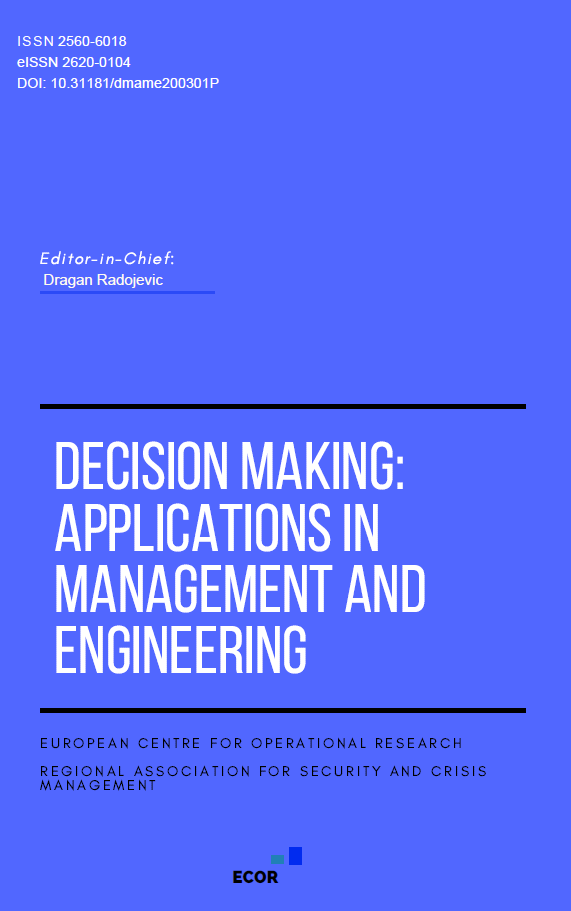Optimized Design and Decision Model Construction of Smart Home Interface for Elderly Users: Integrating Kano-QFD-HCI Methods
DOI:
https://doi.org/10.31181/dmame7120241401Keywords:
smart home; aging-friendly design; QFD-HCI fusion; interface interaction optimization; Kano modelAbstract
Under the background of the deep integration of aging society and intelligent technology, the aging-adapted interface design of smart home products has become a key path to improve the quality of life of the elderly. In the interface design and development of smart home appliances, problems such as complex interaction and imprecise transformation of elderly users' needs often occur. This study proposes a framework that integrates quality function development (QFD) and human-computer interaction (HCI) theory to assist design decisions. The Kano model is used to classify the needs of elderly users in a refined way (basic, aspirational, and excited), and a “user needs-design parameters” quality house model is constructed to realize the quantification of demand priorities and the accurate mapping of design parameters; a multi-dimensional comprehensive evaluation of multiple solutions is carried out by combining the TOPSIS method, and the optimal design is screened out to take into account ease of use, safety, and emotional experience, combined with the TOPSIS method, we conducted a comprehensive evaluation of multiple solutions to select the optimal design solution that takes into account ease of use, safety and emotional experience. The results show that the core needs of elderly users are focused on simplified operation (e.g., one-button start), immediate feedback (e.g., voice prompts), and interface adaptation (e.g., large font, high contrast); the QFD-HCI fusion method can significantly improve the efficiency of requirements transformation and the practicality of design solutions. This study provides theoretical support and practical paradigm for the aging-friendly development and design of smart home products by taking the aging-friendly interface development of smart rice cooker as an example, focusing on exploring the inclusiveness of the elderly group to smart technology and promoting the concept of “technology for the elderly” from concept to realization.
Downloads
References
[1] Saleh, K. T., & Karim, A. A. (2024). Building a dataset of pointing gestures for elderly people in Iraqi nursing homes. Ingénierie des Systèmes d’Information, 29(6), 2455-2465. https://doi.org/10.18280/isi.290632
[2] Li, C. C., Cai, Y. T., Habeeb, L. J., Rahman, A., & Ritzkal, R. (2023). Enhancing Fall Risk Assessment in the Elderly: A Study Utilizing Transfer Learning in an Improved EfficientNet Network with the Gramian Angular Field Technique. Healthcraft Frontiers, 1(1), 1-14. https://doi.org/10.56578/hf010101
[3] Udupa, P., & Yellampalli, S. S. (2018). Smart home for elder care using wireless sensor. Circuit World, 44(2), 69-77. https://doi.org/10.1108/CW-12-2017-0072
[4] Tapia, E. M., Intille, S. S., & Larson, K. (2004). Activity recognition in the home using simple and ubiquitous sensors. In International Conference on Pervasive Computing, pp. 158-175. https://doi.org/10.1007/978-3-540-24646-6_10
[5] Portet, F., Vacher, M., Golanski, C., Roux, C., & Meillon, B. (2013). Design and evaluation of a smart home voice interface for the elderly: acceptability and objection aspects. Personal and Ubiquitous Computing, 17, 127-144. https://doi.org/10.1007/s00779-011-0470-5
[6] Epelde, G., Valencia, X., Carrasco, E., Posada, J., Abascal, J., Diaz-Orueta, U., & Husodo-Schulz, C. (2013). Providing universally accessible interactive services through TV sets: implementation and validation with elderly users. Multimedia Tools and Applications, 67, 497-528. https://doi.org/10.1007/s11042-011-0949-0
[7] Raghu, R., Jayaraman, V., Jayaraman, J., Nukala, S. S. V., & Díaz, V. G. (2022). A multi-layered edge-secured cloud framework for healthcare monitoring in old-age homes using smart systems driven by comprehensive user interaction. International Journal of Safety and Security Engineering, 12(4), 449-457. https://doi.org/10.18280/ijsse.120405
[8] Vujović, M., Ristanović, M., Miloš, M., & Perales Lopez, F. J. (2018). Health monitoring modular panel interface design and evaluation. Thermal Science, 22, S1259-S1270. https://doi.org/10.2298/TSCI170531130V
[9] Courtney, K. L., Demeris, G., Rantz, M., & Skubic, M. (2008). Needing smart home technologies: The perspectives of older adults in continuing care retirement communities. Inform. Prim. Care, 16, 195-201.
[10] Tural, E., Lu, D., & Austin Cole, D. (2021). Safely and actively aging in place: Older adults’ attitudes and intentions toward smart home technologies. Gerontology and Geriatric Medicine, 7, 23337214211017340. https://doi.org/10.1177/23337214211017340
[11] Jiao, J. (2015). Research on visual design of operation interface of smart rice cooker for senior citizens. Beijing University of Technology.
[12] Jing, Y. (2017). Research on the design of rice cooker based on emotionalization. Xi'an Engineering University.
[13] Zallio, M., Kelly, P., Cryan, B., & Berry, D. (2021). A co-design approach for a smart cooking appliance. The application of a domain specific language. In Advances in Usability, User Experience, Wearable and Assistive Technology: Proceedings of the AHFE 2021 Virtual Conferences on Usability and User Experience, Human Factors and Wearable Technologies, Human Factors in Virtual Environments and Game Design, and Human Factors and Assistive Technology, USA, pp. 503-511. https://doi.org/10.1007/978-3-030-80091-8_59
[14] Chen, G., Fu, W., & Luo, Z.Y. (2012). Implement of home appliance control system in smart home based on IEEE 802.15.4e protocol. Video Engineering, 2012(24), 23-25.
[15] Mattheiss, E. E., Schrammel, J., & Tscheligi, M. (2011). Added value of in-situ methods in usability evaluation of a self-service ticketing machine with a view on elderly users: A case study. In Information Quality in e-Health: 7th Conference of the Workgroup Human-Computer Interaction and Usability Engineering of the Austrian Computer Society, USAB 2011, Graz, Austria, pp. 595-606. https://doi.org/10.1007/978-3-642-25364-5_42
[16] Pérez-Espinosa, H., Martínez-Miranda, J., Espinosa-Curiel, I., Rodríguez-Jacobo, J., & Avila-George, H. (2017). Using acoustic paralinguistic information to assess the interaction quality in speech-based systems for elderly users. International Journal of Human-Computer Studies, 98, 1-13. https://doi.org/10.1016/j.ijhcs.2016.09.013
[17] Shil, N. C., Ali, M. A., & Paiker, N. R. (2010). Robust customer satisfaction model using QFD. International Journal of Productivity and Quality Management, 6(1), 112-136. https://doi.org/10.1504/IJPQM.2010.033887
[18] Ali, M. A. M., Omar, A. R., Saman, A. M., Othman, I., & Hadi, I. H. A. (2010, December). Assimilating Quality Function Deployment (QFD) with QUEST® analysis for facility layout redesign of Handwork Section. In 2010 International Conference on Science and Social Research (CSSR 2010), Kuala Lumpur, Malaysia, pp. 985-990. https://doi.org/10.1109/CSSR.2010.5773933
[19] Rao, Y. (2018). Research on QFD-Based e-Government Online Service Quality Optimization Model. Master’s Thesis, Chengdu University of Technology, Chengdu, China.
[20] Sousa-Zomer, T. T., & Miguel, P. A. C. (2017). A QFD-based approach to support sustainable product-service systems conceptual design. The International Journal of Advanced Manufacturing Technology, 88, 701-717. https://doi.org/10.1007/s00170-016-8809-8
[21] Kano, N. (1984). Attractive quality and must-be quality. Journal of the Japanese Society for Quality Control, 31(4), 147-156.
[22] Sireli, Y., Kauffmann, P., & Ozan, E. (2007). Integration of Kano's model into QFD for multiple product design. IEEE Transactions on Engineering Management, 54(2), 380-390. https://doi.org/10.1109/TEM.2007.893990
[23] Tontini, G. (2007). Integrating the Kano model and QFD for designing new products. Total Quality Management, 18(6), 599-612.
[24] Sireli, Y., Kauffmann, P., & Ozan, E. (2007). Integration of Kano's model into QFD for multiple product design. IEEE Transactions on Engineering Management, 54(2), 380-390.
[25] Tontini, G. (2007). Integrating the Kano model and QFD for designing new products. Total Quality Management, 18(6), 599-612.
[26] Chen, C. C., & Chuang, M. C. (2008). Integrating the Kano model into a robust design approach to enhance customer satisfaction with product design. International Journal of Production Economics, 114(2), 667-681. https://doi.org/10.1016/j.ijpe.2008.02.015
[27] Tian, Z., Che, J., Li, J., & Zhang, L. (2017). Research on bicycle modeling requirements based on Kansei Engineering and Kano model. Mech. Des, 34, 113-118.
[28] Chang, Y., Tang, L., & Li, X. (2019). Research on shape design of plant protection UAV Based on Kano model. Mech. Des, 36, 139-144.
[29] Luor, T. T., Lu, H. P., Yu, H., & Lu, Y. (2015). Exploring the critical quality attributes and models of smart homes. Maturitas, 82(4), 377-386. https://doi.org/10.1016/j.maturitas.2015.07.025
[30] Cheng, J., Wu, Y., Huang, H., & Kang, X. (2016). Study of Middle-Aged and Youth Users’ Preference for Smart Homes. In Human-Computer Interaction. Novel User Experiences: 18th International Conference, HCI International 2016, Toronto, ON, Canada, pp. 483-493. https://doi.org/10.1007/978-3-319-39513-5_45
[31] Liu, Y., Tamura, R., & Song, Y. (2020). Constructing a smart home for future elders toward all-around happiness: Taking connectivity as the core element. Applied Sciences, 10(16), 5690. https://doi.org/10.3390/app10165690
[32] Chuang, P. T. (2001). Combining the analytic hierarchy process and quality function deployment for a location decision from a requirement perspective. The International Journal of Advanced Manufacturing Technology, 18, 842-849. https://doi.org/10.1007/s001700170010
[33] Huang, Y. C., Wu, K. Y., & Liu, Y. T. (2013). Future home design: An emotional communication channel approach to smart space. Personal and Ubiquitous Computing, 17, 1281-1293. https://doi.org/10.1007/s00779-012-0635-x
[34] Zhou, Y., & Hu, X. (2021). Internet of things intelligent interaction technology using deep learning in public interaction design. IEEE Access, 10, 3182-3191. https://doi.org/10.1109/ACCESS.2021.3135660
[35] Reig, S., Fong, T., Forlizzi, J., & Steinfeld, A. (2022). Theory and design considerations for the user experience of smart environments. IEEE Transactions on Human-Machine Systems, 52(3), 522-535. https://doi.org/10.1109/THMS.2022.3142112
Downloads
Published
How to Cite
Issue
Section
License
Copyright (c) 2025 Decision Making: Applications in Management and Engineering

This work is licensed under a Creative Commons Attribution 4.0 International License.












